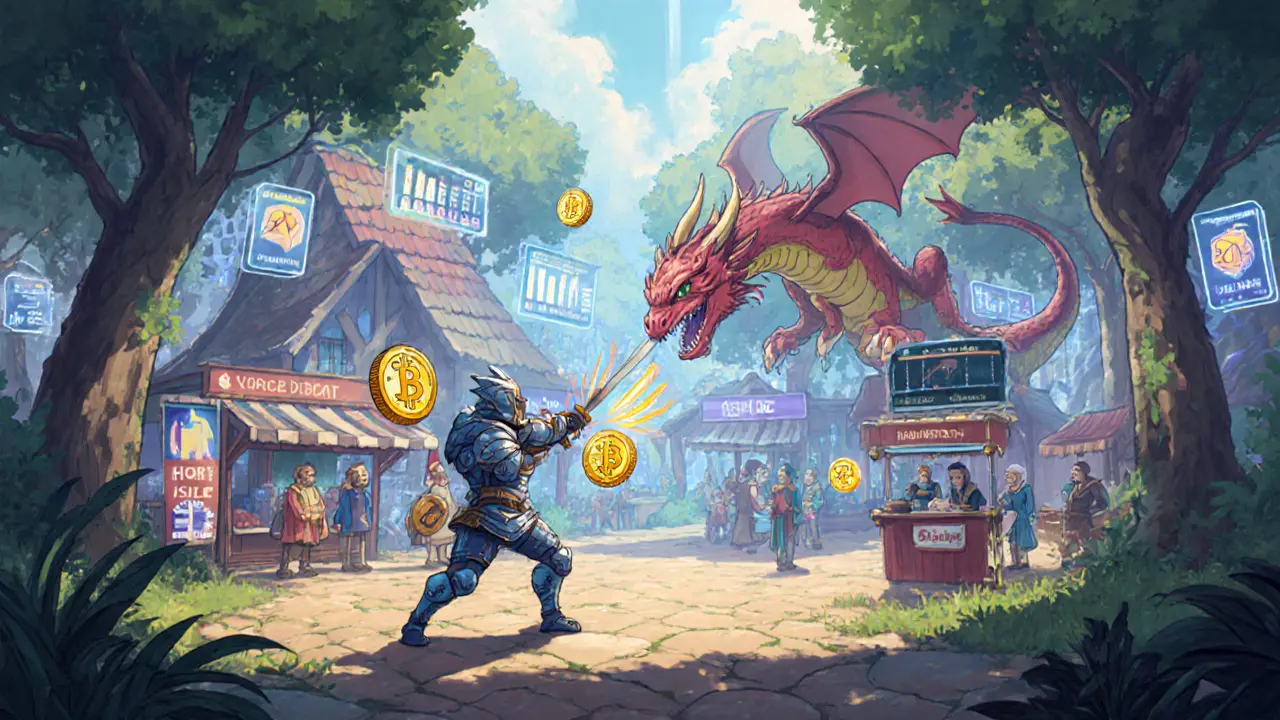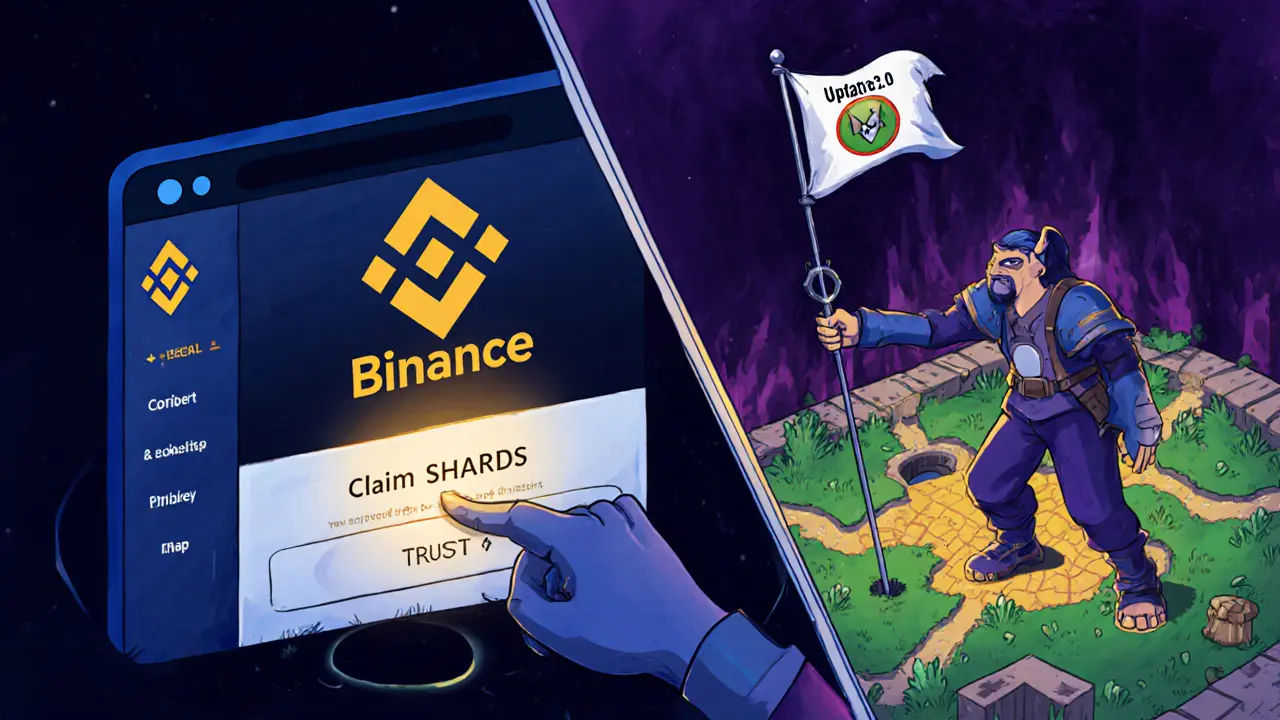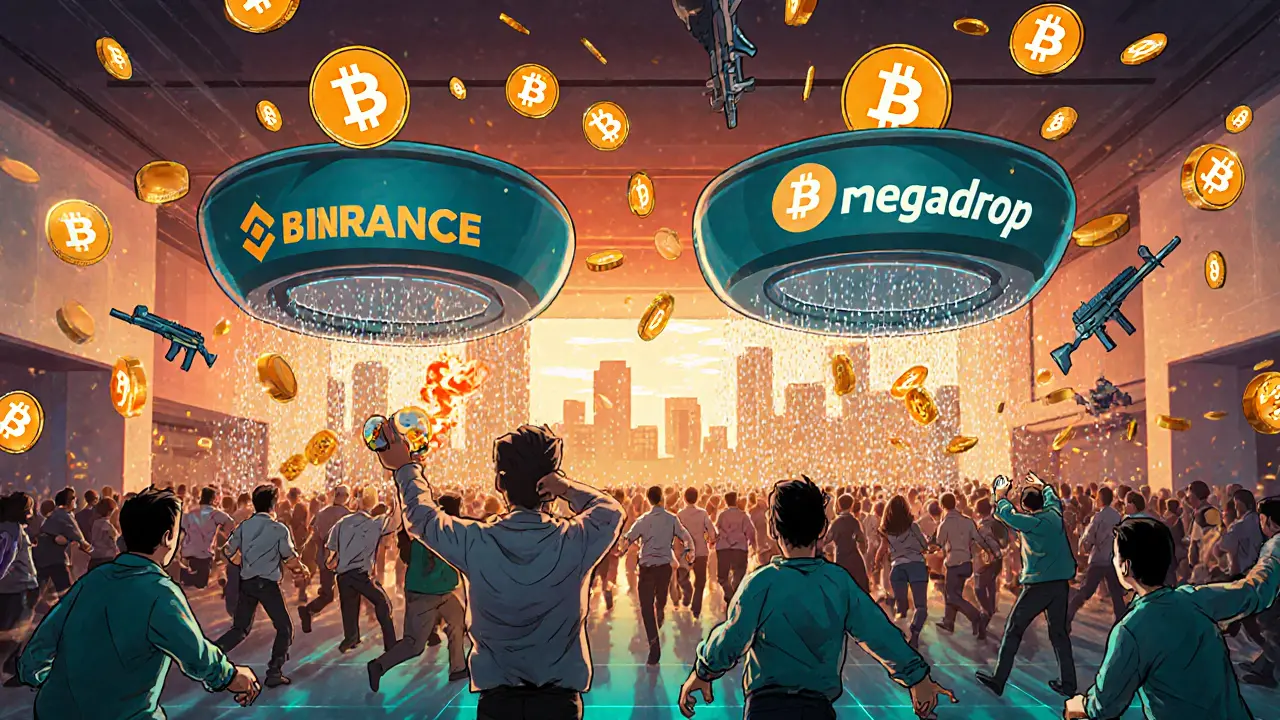SHARDS Airdrop Calculator
How It Worked
This calculator simulates the September 2025 SHARDS airdrop mechanics. Based on your activity on Binance Alpha and Bybit Megadrop, it shows how many tokens you would have earned if you participated.
Binance Alpha Airdrop
Minimum 220 points to claim 4,000 SHARDS. Each claim burns 15 points. Points decreased by 15 per hour. Tokens distributed between Sept 5-9, 2025.
Bybit Megadrop
Stake USDT/MNT for points. Longer staking = more points. Daily trading boosts rewards. Max 1% of 60 million pool per user.
Total Potential SHARDS
Note: The airdrop concluded on September 9, 2025. This is a historical simulation only.
Back in September 2025, thousands of crypto users logged into Binance and Bybit not to trade, but to claim something free: SHARDS tokens. Not just any token - this was the native currency of WorldShards, a new Web3 MMORPG promising full NFT ownership, cross-platform play (PC, mobile, console), and a fair launch with no team or investor allocations. The airdrop wasn’t just a giveaway. It was a carefully engineered test of community commitment, and it worked - for some, it paid off. For others, it faded into the noise.
How the SHARDS Airdrop Actually Worked
The SHARDS airdrop didn’t happen in one place. It split across two major exchanges, each with its own rules. If you didn’t know both, you missed out. On Binance Alpha, you needed Alpha Points. Not just any points - you had to hold at least 220 to claim 4,000 SHARDS. Sounds simple? It wasn’t. Every time you claimed, you burned 15 points. And every hour, the minimum point requirement dropped by 15. That meant if you waited too long, you could claim with fewer points. But if you waited too long, the tokens ran out. The system was designed to create urgency. People refreshed pages every few minutes. Some set alarms. Others hired bots. The first 24 hours were a rush. After that, unclaimed tokens vanished. No reminders. No second chances. Tokens landed straight in your spot wallet - no manual claiming, no gas fees, no delays. Bybit ran a different game. Their Megadrop program, already proven with earlier projects, offered a 60 million SHARDS prize pool. To earn points, you had to stake USDT or MNT in Fixed Term Earn. The longer you staked, the more points you got. You could also boost your score by trading spot pairs daily. The more you traded, the higher your multiplier. Rewards came in three batches between September 5 and 9, 2025. The catch? You could only claim up to 1% of the total pool. That capped individual gains, but spread the wealth. This wasn’t a lottery. It was a participation ladder.Why SHARDS Was Different From Other Airdrops
Most airdrops in 2025 were either DeFi incentives or speculative tokens with no real use. SHARDS had a game behind it. WorldShards wasn’t just a whitepaper. It was a full-scale MMORPG in development with playable demos, a known team, and clear milestones. That made it rare. The fair launch was the biggest differentiator. No team tokens. No private sale. No venture capital backing. Every single SHARDS token went to users who earned it. That’s not common. In fact, it’s almost unheard of in Web3 gaming. Most projects reserve 15-25% for founders. SHARDS didn’t. That built instant trust. People didn’t just want the tokens - they wanted to believe in the project. It also targeted the right audience. Not beginners. Not casual crypto users. It went after people who already understood staking, trading incentives, and platform points. That meant the early adopters weren’t just speculators. They were gamers who knew what NFTs could do in RPGs. They were DeFi users who understood tokenomics. That’s a powerful combo.
What Happened After the Airdrop
On September 5, 2025, SHARDS listed on Bybit Spot. That’s when the real test began. Historically, tokens that launch on Binance Alpha see 30-60% price jumps within days. SHARDS didn’t break that pattern. Early buyers saw quick gains. But then came the drop. Web3 game tokens are volatile. They rise on hype, fall on feedback. Within two weeks, SHARDS dropped 18% as players tested early builds and found bugs. Some complained about lag on mobile. Others said the NFT economy felt unbalanced. The team responded fast - updated patches, fixed UI issues, added new quests. That kept the community from collapsing. Trading volume dipped 7.96% in the first month. That scared some. But analysts noted it was normal. Game tokens don’t trade like Bitcoin. They trade like in-game currency. Demand spikes when new content drops, dips when players take breaks. The real signal wasn’t volume - it was active wallet growth. And that kept climbing. By October 2025, over 120,000 unique wallets held SHARDS. More than 40% of them had used the token in-game - buying skins, upgrading weapons, trading rare items. That’s the metric that matters. Not price. Not volume. Usage.The Risks No One Talked About
People focused on the airdrop mechanics. Few talked about the real risks. First: phishing scams exploded. Fake websites popped up claiming to be “SHARDS Claim Portals.” They looked just like Binance or Bybit. Users lost tokens by entering private keys. The official teams never asked for keys. Ever. Second: regulatory gray zones. SHARDS was built to be decentralized. But if regulators decide it’s a security because it’s tied to a game’s economy, things could get messy. That’s not a threat yet - but it’s a shadow. Third: player retention. Games die when people stop playing. WorldShards needed to keep releasing new content - maps, bosses, events - every 4-6 weeks. If they didn’t, the token’s utility would fade. No one buys a sword if no one’s fighting.
Was It Worth It?
For users who held onto their SHARDS and played the game? Yes. They got more than tokens. They got access to a new kind of digital world - one where what you earn is yours to keep, sell, or trade. You didn’t just play. You owned. For those who cashed out immediately? Maybe. They made a quick profit, but missed the point. SHARDS isn’t a pump. It’s a key. To a game. To a community. To an economy. The airdrop was a success not because tokens rose. It was a success because people showed up. Not just to claim, but to play. To build. To stick around.What Comes Next for SHARDS
As of October 2025, the WorldShards team has released two major updates: a new dungeon zone and a player-driven marketplace. They’re testing cross-platform character sync between PC and mobile. Console versions are on track for Q1 2026. The token’s utility is expanding. You can now use SHARDS to vote on new NPC designs, fund player-created quests, or rent out your NFT gear to others. That’s not just a token. That’s a governance system. The team says they’re targeting 500,000 active players by mid-2026. If they hit that, SHARDS could become one of the most used gaming tokens in Web3. For now, the airdrop is over. But the game has just begun.Did the WorldShards airdrop still happen in October 2025?
No, the main airdrop campaigns ended in early September 2025. Both Binance Alpha and Bybit Megadrop completed their distributions by September 9, 2025. Tokens were distributed directly to wallets, and no further claims are possible. Any website claiming to offer SHARDS airdrops after that date is likely a scam.
How many SHARDS tokens were distributed in total?
The Bybit Megadrop distributed 60,000,000 SHARDS tokens. The Binance Alpha airdrop distributed an additional 20-25 million, based on claim rates and point usage. Total distribution is estimated between 80-85 million SHARDS, all going to community participants with no team or investor allocations.
Can I still earn SHARDS tokens today?
You can’t earn them through airdrops anymore, but you can buy SHARDS on spot markets like Bybit or other exchanges where it’s listed. You can also earn them in-game by completing quests, winning battles, or trading NFT items. The game’s economy is designed to reward active players, not just speculators.
Is WorldShards a scam?
There’s no evidence WorldShards is a scam. The team is public, the game has playable demos, and the airdrop was structured transparently with no hidden allocations. However, like any Web3 project, it carries risks. The game must succeed for the token to hold long-term value. Watch for updates, avoid phishing sites, and never share your private keys.
What’s the best way to use SHARDS tokens now?
The best use is inside the WorldShards game. Buy weapons, skins, and gear with SHARDS. Trade NFTs on the in-game marketplace. Vote on community proposals. Hold if you believe in the game’s future. Selling immediately after the airdrop was profitable for some, but missing the gameplay means missing the real value - ownership in a living digital world.

This was one of the few airdrops that actually felt meaningful. Not just free money, but a real shot at being part of something bigger. I claimed my SHARDS, jumped into the game, and now I’ve got a sword I bought with tokens that I can sell later if I want. That’s ownership. That’s Web3 done right. 🌟
yo the binance alpha thing was a nightmare i set up a script to auto-refresh but the site kept 429ing me and i missed the last 5k shards bc i was asleep 😭 the bybit one was way better tho staking usdt for points was lowkey genius
As a Nigerian gamer who has seen too many 'decentralized' projects vanish overnight, I approached SHARDS with caution. But the transparency-no team allocations, public roadmap, playable demos-was refreshing. The token’s utility within the game is not speculative; it is structural. In Africa, where digital ownership is often a luxury, this model offers dignity. May it thrive.
It’s not about the tokens. It’s about the illusion of ownership. You think you own your sword? You don’t. The devs can change the rules tomorrow. This isn’t freedom. It’s gamified capitalism with a pretty UI.
Let’s be real-this whole thing was a marketing stunt wrapped in Web3 jargon. You call it a 'fair launch' but you still had to hold 220 Alpha Points? That’s not fair, that’s gatekeeping with a side of FOMO. And don’t get me started on Bybit’s staking system-those who could afford to lock up USDT for months got 10x the rewards. This wasn’t for the community. It was for the whales. And now everyone’s pretending it’s some revolutionary model when it’s just another pump disguised as a game. The 'active wallet growth' metric? That’s just the same 5,000 people trading their own NFTs back and forth. Wake up.
SHARDS dropped 18%? That’s a failure. If it can’t hold value for two weeks, it’s trash. Also, why are people still talking about this? The airdrop was months ago. Move on.
Man I still remember logging in the day the game launched. First time I ever felt like my time actually mattered in a crypto project. I spent 3 hours farming a rare shield and sold it for 1200 SHARDS. Bought a skin for my buddy. We laughed. That’s the magic. Not the price chart. 🎮❤️
Everyone’s arguing about tokens and price action, but the real win here is the community. I’ve seen people from Brazil, Japan, and South Africa team up in-game because they all got SHARDS. No language barrier, just shared goals. That’s rare. The token’s just the glue. The real asset is the people.
120k wallets? Cute. But 90% of them are bots or dead addresses. The real active users? Maybe 15k. And half of those are just farming quests to dump tokens. This isn’t a game economy-it’s a Ponzi with better graphics. The team’s just buying time until they exit. Watch the next update-there’ll be a 'liquidity event' disguised as a 'community event.'
There’s a deeper truth here: the airdrop didn’t distribute tokens. It distributed trust. People didn’t just claim SHARDS-they believed in a promise that someone, somewhere, would build something worth owning. That’s rare in this space. Whether the game succeeds or fails, that trust remains. And trust, in the end, is the only thing that can’t be airdropped.
Just wanted to say thank you to the devs for not taking a single token for themselves. I know it’s easy to say 'fair launch' but actually doing it? That’s huge. I’m not rich from this, but I feel like I’m part of something honest. That counts for more than any price tag. 🙏
Let’s cut the woke crypto nonsense. This was a US-centric, VC-funded vanity project disguised as decentralization. The 'no team allocation' claim? Bullshit. They just delayed vesting until after the airdrop. And now they’re pushing cross-platform sync to lock in users before regulators catch on. This isn’t Web3-it’s Web2 with NFT stickers. And if you’re still holding SHARDS, you’re the sucker who didn’t cash out at 0.12.